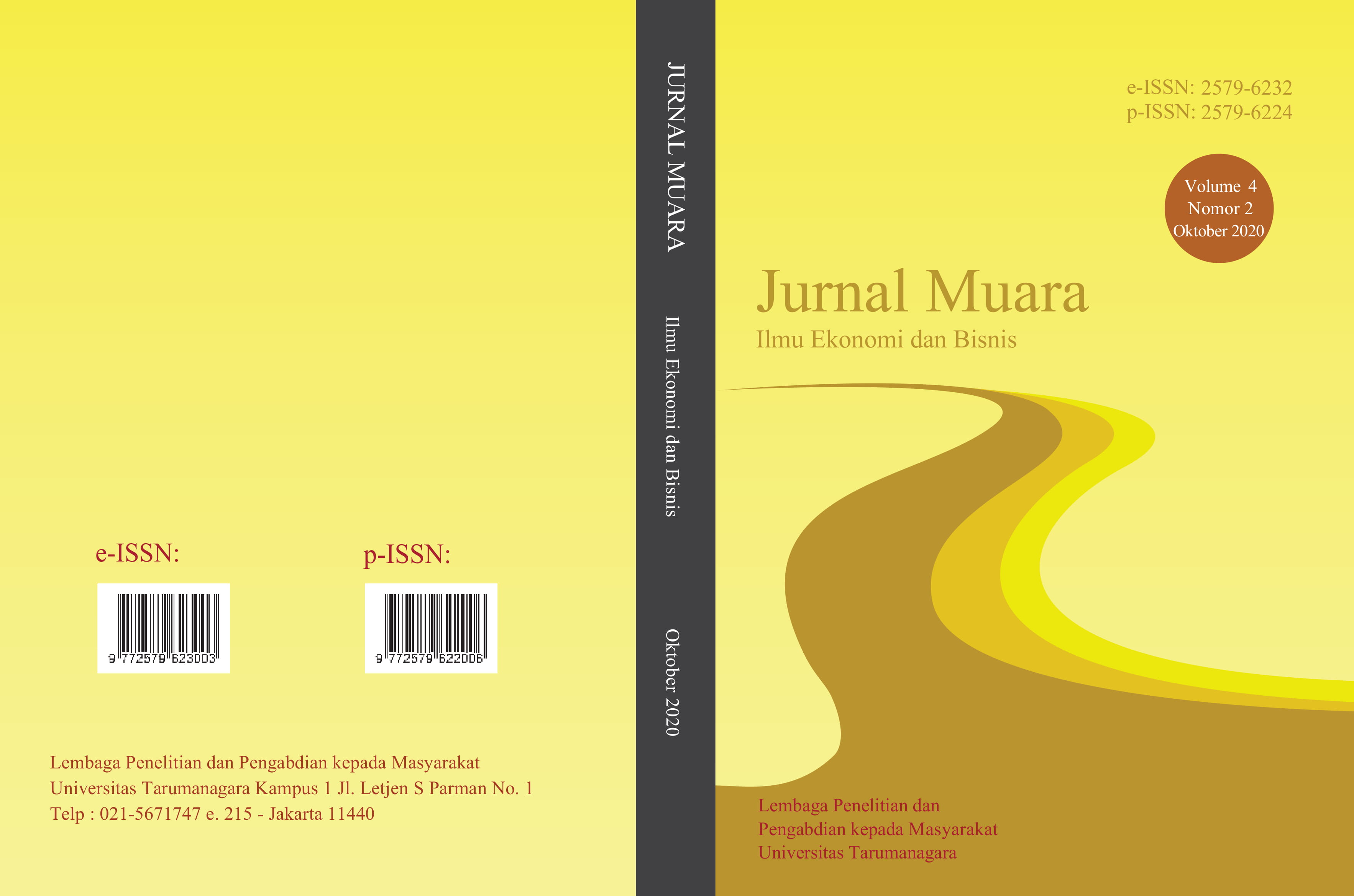DETERMINED CONSUMERS ONLINE PURCHASE INTENTION FACTORS BY CONSIDERING RISK AND E-TRUST
Main Article Content
Abstract
Niat pembeli adalah salah satu pendorong utama bagi pembeli untuk melakukan transaksi pembayaran dan akhirnya membeli produk atau layanan. Semakin tinggi niat beli, semakin besar keinginan individu untuk membeli barang. Ini juga berlaku untuk pembelian online menggunakan e-commerce. Transaksi pembelian online memiliki karakteristik bahwa tidak ada interaksi fisik antara pembeli, penjual, dan proses pembayaran. Niat pembelian online dapat dipengaruhi oleh berbagai faktor. Berdasarkan studi sebelumnya, faktor-faktor penting dalam pembelian online adalah faktor pengalaman berbelanja, risiko yang mungkin, dan kepercayaan pada situs web penyedia layanan e-commerce. Penelitian ini bertujuan untuk mengetahui faktor-faktor yang berpengaruh dalam niat pembelian online dengan membangun model penelitian. Model dalam penelitian ini adalah kombinasi variabel penelitian dari penelitian sebelumnya. Ada tujuh variabel penelitian dengan sepuluh hipotesis penelitian. Variabel yang digunakan untuk menyusun model penelitian adalah Pengalaman Belanja Online, Kualitas Web, Risiko Produk, Risiko Keuangan, Risiko Privasi, E-Trust, dan Niat Pembelian Online. Tahap selanjutnya dari penelitian ini adalah melakukan survei penelitian dan mengolah hasil data menggunakan SMART PLS 3.0.
The buyer's intention is one of the main drivers for a buyer to make payment transactions and end up buying products or services. The higher the purchase intentions, the greater the willingness of the individual to buy the goods. This also applies to online purchases using e-commerce. Online purchase transactions have the characteristic that there is no physical interaction between the buyer, seller, and payment process. The online purchase intention can be influenced by various factors. Based on previous studies, important factors in online purchasing are shopping experience factors, possible risks, and trust in e-commerce service provider websites. This study aims to determine the influential factors in online purchase intention by building a research model. The model in this study is a combination of research variables from previous studies. There are seven research variables with ten research hypotheses. The variables used to compile the research model are Online Shopping Experience, Web Quality, Product Risk, Financial Risk, Privacy Risk, E-Trust, and Online Purchase Intention. The next stage of this research is to conduct a research survey and processing the results of data using SMART PLS 3.0.
Article Details
References
M. Cortinas, R. Cabeza, R. Chocarro, and A. Villanueva, "Attention to online channels across the path to purchase: An eye-tracking study," Electronic Commerce Research and Applications, vol. 36, 2019, doi: doi.org/10.1016/j.elerap.2019.100864.
W.-I. Lee, S.-Y. Cheng, and Y.-T. Shih, "Effects among product attributes, involvement, word-of-mouth, and purchase intention in online shopping," Asia Pacific Management Review, vol. 22, no. 4, pp. 223-229, 2017, doi: doi.org/10.1016/j.apmrv.2017.07.007.
I. B. Hong and H. S. Cha, "The mediating role of consumer trust in an online merchant in predicting purchase intention," International Journal of Information Management, vol. 33, no. 6, pp. 927-939, 2013, doi: doi.org/10.1016/j.ijinfomgt.2013.08.007.
H. Siagian and E. Cahyono, "ANALISIS WEBSITE QUALITY, TRUST DAN LOYALTY PELANGGAN ONLINE SHOP," Jurnal Manajemen Pemasaran, vol. 8, no. 2, pp. 55-61, 2014, doi: https://doi.org/10.9744/pemasaran.8.2.55-61.
B. Ganguly, S. B. Dash, D. Cyr, and M. Head, "The effects of website design on purchase intention in online shopping: The mediating role of trust and the moderating role of culture," International Journal of Electronic Business vol. 8, no. 4, pp. 302-330, 2010, doi: DOI: 10.1504/IJEB.2010.035289.
H. Amadea, Keni, and L. Soelaiman, "Pengaruh Past Experience dan Perceived Risk Terhadap Purchase Intention Pada Situs Rakuten.co.id Di Jakarta Dengan Customer Trust Sebagai Variabel Moderator," in Conference on Management and
Behavioral Studies, Jakarta, 2016: Universitas Tarumanagara.
H. K. Chi, H. R. Yeh, and Y. T. Yang, "The Impact of Brand Awareness on Consumer Purchase Intention: The Mediating Effect of Perceived Quality and Brand Loyalty," Journal of International Management Studies, vol. 4, pp. 135-144, 2009.
S. Mohseni, S. Jayashree, S. Rezaei, A. Kasim, and F. Okumus, "Attracting tourists to travel companies’ websites: the structural relationship between website brand, personal value, shopping experience, perceived risk and purchase intention," Current Issues in Tourism, vol. 21, no. 6, pp. 616-645, 2016, doi: 10.1080/13683500.2016.1200539.
B. Dai, S. Forsythe, and W.-S. Kwon, "The Impact Of Online Shopping Experience On Risk Perceptions And Online Purchase Intentions: Does Product Category Matter?," Journal of Electronic Commerce Research, vol. 15, no. 1, pp. 13-24, 2014.
L. Wang, R. Law, B. D. Guillet, K. Hung, and D. K. C. Fong, "Impact of Hotel Website Quality on Online Booking Intentions: eTrust as a Mediator," International Journal of Hospitality Management, vol. 47, pp. 108-115, 2015, doi: https://doi.org/10.1016/j.ijhm.2015.03.012.
S. K. Ariffin, T. Mohan, and Y.-N. Goh, "Influence of consumers’ perceived risk on consumers’ online purchase intention," Journal of Research in Interactive Marketing, vol. 12, no. 2, 2018, doi: DOI: 10.1108/JRIM-11-2017-0100.
E. Y. Masoud, "The Effect of Perceived Risk on Online Shopping in Jordan," European Journal of Business and Management, vol. 5, no. 6, 2013.
Y. Naiyi, "Dimensions of Consumer’s Perceived Risk in Online Shopping " Journal of Electronic Science and Technology of China, vol. 2, no. 3, pp. 177-182, 2004.
S. C. Chen and G. S. Dhillon, "Interpreting Dimensions of Consumer Trust in E-Commerce," Information Technology and Management, vol. 4, no. 2-3, pp. 303-318, 2003, doi: https://doi.org/10.1023/A:1022962631249.
I. Ghozali, Structural Equation Modeling Metode Alternatif Dengan Partial Least Square, 2 ed. Semarang: Universitas Diponegoro, 2014.
J. Henseler, C. M. Ringle, and M. Sarstedt, "A new criterion for assessing discriminant validity in variance-based structural equation modeling," J. of the Acad. Mark. Sci, vol. 43, pp. 115-135, 2015, doi: 10.1007/s11747-014-0403-8.



